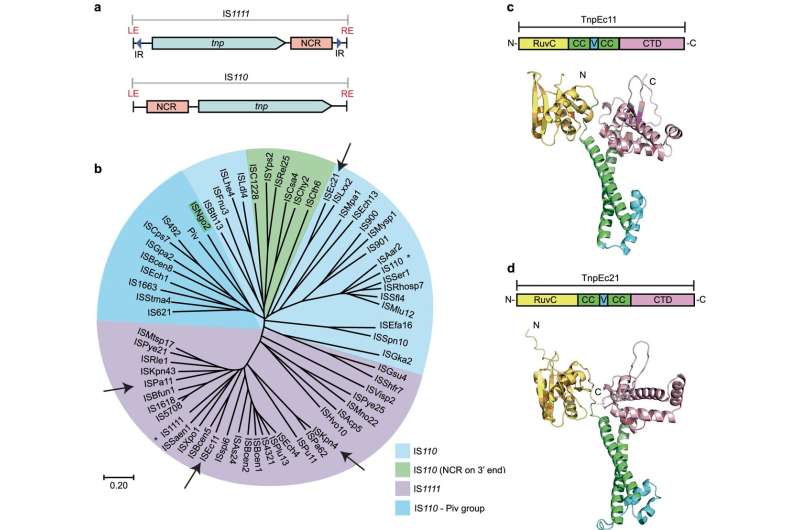
Features of the IS1111 and IS110 family. Credit: Nature Communications (2024). DOI: 10.1038/s41467-024-49474-9
Scientists at the University of Sydney have developed a gene-editing tool with greater precision and flexibility than the industry standard, CRISPR, which has revolutionized genetic engineering in medicine, agriculture and biotechnology.
SeekRNA uses a programmable ribonucleic acid (RNA) array that can directly identify sites for insertion into genetic sequences, simplifying the editing process and reducing errors.
The new gene editing tool is being developed by a team led by Dr. Sandro Ataide in the School of Life and Environmental Sciences. Their findings are published in Nature Communications.
“We are extremely excited by the potential of this technology. SeekRNA’s ability to target selection with precision and flexibility sets the stage for a new era of genetic engineering, overcoming the limitations of current technologies,” said Dr. Ataide.
“With CRISPR you need additional components to have a ‘cut and paste tool’, whereas seekRNA’s promise is that it is a standalone, higher precision ‘cut and paste tool’ that can provide a wide range of DNA sequences.”
CRISPR relies on creating a break in both strands of the target DNA, the double-stranded genetic code of life, and needs other proteins or the DNA repair machinery to insert the new DNA sequence. of. This may introduce errors.
Dr. Ataide said, “SeekRNA can precisely cleave the target site and insert the new DNA sequence without the use of any other proteins. This allows for a much cleaner editing tool with higher accuracy and fewer errors. “
Gene editing has opened up entirely new areas of research and application since the development of CRISPR more than 10 years ago. It has led to improvements in disease resistance in fruits and crops, reduced the cost and speed of detecting human diseases, aided in the search for a cure for sickle cell disease, and allowed the development of a revolutionary cancer treatment known as ( CAR) T-cell therapy.
“We are very much in the early days of what gene editing can do. We hope that by developing this new approach to gene editing, we can contribute to advances in health, agriculture and biotechnology,” said joint author Professor Ruth Hall from the University. of Sydney.
Exact genetic assignment
SeekRNA is derived from a family of naturally occurring insertion sequences known as IS1111 and IS110, discovered in bacteria and archaea (cells without a nucleus). Most insertion sequence proteins exhibit little or no target selectivity, yet these families exhibit high target specificity.
It is this precision that seekRNA has used to achieve its promising results to date. Using the precision from this family of insertion sequences, seekRNA can modify any genomic sequence and insert new DNA in a precise orientation.
“In the laboratory we have successfully tested seekRNA in bacteria. Our next steps will be to investigate whether the technology can be adapted to the more complex eukaryotic cells found in humans,” said Dr. Ataide.
An advantage of the system reported in this study is that it can be applied using only a single protein of modest size plus a short strand of seekRNA to efficiently drive genetic cargo. SeekRNA consists of a small protein of 350 amino acids and an RNA strand of 70 to 100 nucleotides.
A system of this size can be packaged into nanoscale biological delivery vehicles (vesicles or lipid nanoparticles) for delivery to cells of interest.
Direct insertion into DNA
Another point of differentiation is the ability of this technology to insert DNA sequences into the desired location itself, a feat impossible with many current editing tools.
“Current CRISPR technology has limitations on the size of genetic sequences that can be introduced,” said University of Sydney research associate Rezwan Siddiquee, lead author of the paper. “This limits the scope of application.”
Globally, other teams are pursuing similar research into the editing potential of IS1111 and IS110 family genes. However, Dr. Ataide says they have only shown results for one member of the IS110 family and rely on a much larger version of the RNA. The team in Sydney is advancing its technique by taking direct laboratory samples and applying the shorter seekRNA itself.
More information:
Rezwan Siddiquee et al, A programmable seekRNA directs target selection by IS1111 and IS110-type insertion sequences, Nature Communications (2024). DOI: 10.1038/s41467-024-49474-9
Provided by the University of Sydney
citation: Beyond CRISPR: seekRNA yields new pathway for accurate gene editing (2024, June 21) retrieved June 22, 2024 from https://phys.org/news/2024-06-crispr-seekrna-pathway-accurate- gene.html
This document is subject to copyright. Except for any fair agreement for study or private research purposes, no part may be reproduced without written permission. The content is provided for informational purposes only.